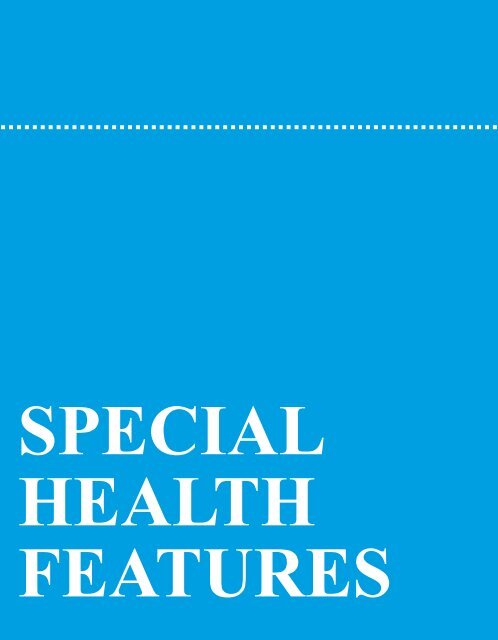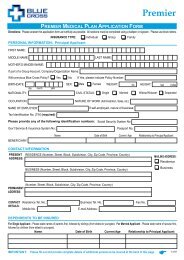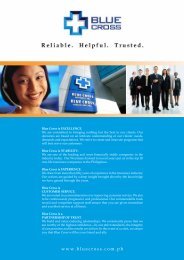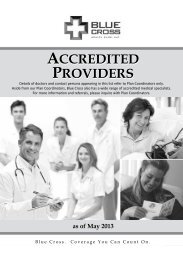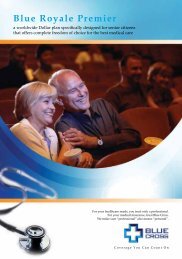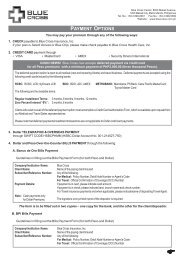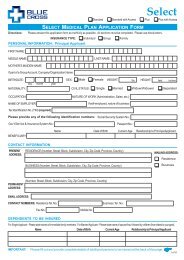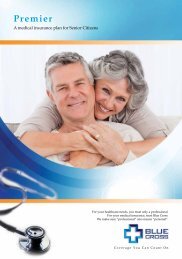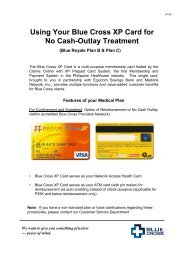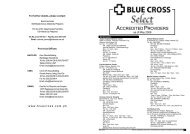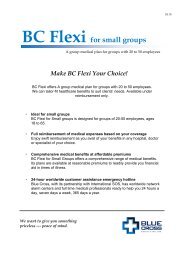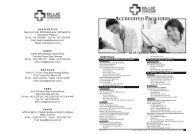Health Book_03-Special Features_2011_web.pdf - Blue Cross
Health Book_03-Special Features_2011_web.pdf - Blue Cross
Health Book_03-Special Features_2011_web.pdf - Blue Cross
You also want an ePaper? Increase the reach of your titles
YUMPU automatically turns print PDFs into web optimized ePapers that Google loves.
<strong>Blue</strong> <strong>Cross</strong> <strong>Health</strong> BOOKSPECIALHEALTHFEATURES
II<strong>Blue</strong> cross <strong>Health</strong> BOOKa better way to eatTHE NEW FOOD PYRAMIDEat and exercise to a healthy life!THE NEW FOOD PYRAMIDMake half yourgrains wholeEat at least 3 oz. ofwholegrain cereals,breads, crackers, rice,or pasta everyday.1 oz. is about 1 sliceof bread, about 1 cupof breakfast cereal, or1/2 cup of cooked rice,cereal or pasta.Vary yourveggiesEat more dark-greenveggies like broccoli,spinach, and other darkleafy greens.Eat more orange vegetableslike carrots andsweet potatoes.Eat more dry beans andpeas like pinto beans,kidney beans, andlentils.Focus onfruitsEat a variety of fruit.Choose fresh, frozen,canned, or dried fruit.Go easy on fruit juices.Get yourcalcium-rich foodsGo low-fat or fat-freewhen you choose milk,yogurt, and other milkproducts.If you don’t or can’tconsume milk, chooselactose-free products orother calcium sourcessuch as fortified foodsand beveragesPhysical Activity: Be physically active for at least 30 minutes most days of the week.Go leanwith proteinChoose low-fat or leanmeats and poultry.Bake it, broil it, or grill it.Vary your proteinroutine - choose morefish, beans, peas, nuts,and seeds.
<strong>Blue</strong> <strong>Cross</strong> <strong>Health</strong> BOOKIIIbe healthy! be free!10 HABITS OF HEALTHY PEOPLEBelieve it or not, living a healthy life is simple. Here are basic health tips that could lead you tobeing fit and fabulous . Make it a habit to go back to these basic healthy habits now!12345678910<strong>Health</strong>y people drink eight to ten glasses of water everyday. Drinking plenty of waterhelps flush out harmful toxins from the body. It also keeps you well hydrated, providingessential moisture to your skin and body.<strong>Health</strong>y people exercise regularly. Thirty minutes of exercise everyday promotes betterblood and nutrient circulation to the body. Exercise helps tone and strengthen muscles.Studies have also shown that people who exercise regularly have a happier and morepositive disposition in life.<strong>Health</strong>y people get enough sleep and rest. A good night’s sleep allows your tissues torejuvenate and get adequate amounts of oxygen. Enough rest will also help you feel lessstressed and cranky within the day.<strong>Health</strong>y people eat lots of fruits and vegetables. An all-natural, organic and colorfuldiet of fresh fruits and vegetables ensures that your body is getting the right minerals andvitamins. This kind of diet also lessens your chances of being overweight or obese sincefruits and vegetables are high in nutrients but low in fat.10 HABITS OF HEALTHY PEOPLE<strong>Health</strong>y people don’t smoke. Smoking increases your risk of lung cancer, heart disease,and a host of other illnesses. It also destroys the Vitamin C stored in your body and hampersblood and oxygen circulation in the body.<strong>Health</strong>y people limit their intake of saturated fats. An unhealthy intake of saturatedfats, found mostly in butter, whole milk, cold cuts and beef, has been associated with awide range of medical conditions including heart disease, cancer, obesity and diabetes.<strong>Health</strong>y people load up on fiber. Your risk of getting constipation, colon cancer andbreast cancer is dramatically reduced by increasing your fiber intake. Fiber also promotesa good digestive system. Fiber rich foods include whole grains and beans.<strong>Health</strong>y people take the correct vitamin and mineral supplements. A multivitaminloaded with minerals, and preferably an anti-oxidant formula, calcium, folic acid, VitaminC and E, will add to your over-all health regimen.<strong>Health</strong>y people avoid refined and processed food, sugar, white flour and alcohol.These types of food pack on the calories but are virtually zero in good nutrition.<strong>Health</strong>y people know how to relax and unwind. Taking time out to de-stress everyday contributes greatly to your total well-being as a person. Meditation prevents you fromfocusing on negative thoughts and draining your mental and emotional energies. By takinga breather, you not only have a healthy body, but a healthy soul as well.10 HABITS OF HEALTHY PEOPLE
IV<strong>Blue</strong> cross <strong>Health</strong> BOOKstep up!WHY DON’T YOU GO TAKE A WALK?Walking is one of the body’s most natural forms of exercise. It’s free and requires no prescription. Walking is simple- just one foot in front of the other. Step up and start today.A diabetes prevention study showed that those who walked five times a week for 30 minutes,lost 3 to 7% of their body weight and reduced their risk of diabetes by 58%. Those over age60 reduced their risk by 71%, a result unmatched by any other drug.Walking is cheap mental and emotional therapy. Studies show time and again that regularexercise can relieve stress and depression.Women who averaged more than 10,000 steps a day had only 26% body fat, well within theBMI recommended body range, while those who averaged fewer than 6,000 steps a day had44% body fat.Studies of men and women show that regular walking is related to lower risks of dementia andbetter thinking abilities as they age.Walking for 30 minutes a day for 4 weeks can improve various health measures by 44%. If youwalk at least 10,000 steps a day over the same period, your health measures improve by 76%.WHY DON’T YOU GO TAKE A WALKPhysically active employees take 27% less sick days than non-active employees.Taking short, brisk-10 minute walks four times a day can decrease your blood pressure for 11hours. Taking a 40 minute continuous walk can keep it down for seven hours.Research shows that walking can reduce your risk of catching a cold.Studies have shown that individual work performance can be improved by 15% when peopleengage in regular physical activity.Research says that if you walk regularly, you are saving $330 (around Php15,000) in healthcare costs every year. These costs include doctor visits, hospitalization and prescription drugs.A study that assigned older adults to a walking group found that they were less distractible andcould concentrate better.Walking keeps your heart healthy by lowering low-density lipoprotein (LDL – L for lethalcholesterol) cholesterol and raising high-density cholesterol (HDL – H for healthy cholesterol).As you get older, walking for physical fitness can prevent falls, help you staymobile and maintain independence.
<strong>Blue</strong> <strong>Cross</strong> <strong>Health</strong> BOOKVburning fast foodPORTION DISTORTIONSee how calorie portions have evolved through the past twenty years.SODA20 years ago‣ A 6.5 ounce sodahad 85 calories.Today‣ A 20 ounce soda has 250calories, 165 more caloriesthan a portion 20 years ago.If you’re a 160 pound person, you’llneed to work in the garden for 35minutes, to burn around 165 calories.CHEESEBURGER20 years ago‣ A cheeseburger had333 calories.Today‣ Today’s fastfood cheeseburgerhas 590 calories, 257 morecalories than a portion 20years ago.If you’re a 130 pound person, you’llneed to lift weights for 1 hour and 30minutes to burn around 257 calories.FRENCH FRIES20 years ago‣ 2.4 ounces of french frieshad 210 calories.Today‣ Today’s portion of French friesis 6.9 ounces and has 610calories, 400 more caloriesthan a portion 20 years ago.If you’re a 160 pound person, you’llneed to walk leisurely for 1 hourand 10 minutes to burn around 400calories.Spaghetti and mEATBALLS20 years ago‣ 1 cup spaghetti with sauce& 3 small meatballs‣ 500 caloriesToday‣ 2 cups of pasta with sauce& 3 large meatballs‣ 1,025 caloriesIf you are a 130 pound person,you will need to clean the house foraround 2 hours and 35 minutes toburn approximately 525 calories.COFFEE20 years ago‣ 8 ounces of coffee(with whole milk & sugar)‣ 45 caloriesToday‣ 16 ounces of mocha coffee(with steamed whole milk andmocha syrup)‣ 355 caloriesIf you are a 130 pound person, youwill need to walk for 1 hour and 20minutes to burn approximately 305calories.MUFFIN20 years ago‣ 1.5 ounces‣ 210 caloriesToday‣ 4 ounces‣ 500 caloriesIf you are a 130 pound person,you will need to vacuumfor 1 hour and 30 minutesto burn approximately 290 calories.Source: National Heart Lung and Blood Institute <strong>web</strong>site. http://www.nhlbihin.net.PORTION DISTORTION
VI<strong>Blue</strong> cross <strong>Health</strong> BOOKachieve your ideal weightIDEAL HEIGHT AND WEIGHT CHARTSThe key to weight management is a healthy lifestyle. Set a realistic goal and achieve your ideal weight now!MENWOMENHeightSMALLFRAMEMEDIUMFRAMELARGEFRAMEHeightSMALLFRAMEMEDIUMFRAMELARGEFRAME5’2”128-134131-141138-1504’10”102-111109-121118-1315’3”130-136133-143140-1534’11”1<strong>03</strong>-113111-123120-1345’4”132-138135-145142-1565’0”104-115113-126122-137IDEAL HEIGHT AND WEIGHT CHARTS5’5”5’6”5’7”5’8”5’9”5’10”5’11”6’0”6’1”6’2”6’3”6’4”134-140136-142138-145140-148142-151144-154146-157149-160152-164155-168158-172162-176137-148139-151142-154145-157148-160151-163154-166157-170160-174164-178167-182171-187144-160146-164149-168152-172155-176158-180161-184164-188168-192172-197176-202181-2075’1”5’2”5’3”5’4”5’5”5’6”5’7”5’8”5’9”5’10”5’11”6’0”106-118108-121111-124114-127117-130120-133123-136126-139129-142132-145135-148138-151115-129118-132121-135124-138127-141130-144133-147136-150139-153142-156145-159148-162125-140128-143131-147134-151137-155140-159143-163146-167149-170152-173155-176158-179
<strong>Blue</strong> <strong>Cross</strong> <strong>Health</strong> BOOKVIIamazing!YOUR AMAZING BODYYour body is an intricate and wonderful weave of systems. Take care of it!• When you were born, you had around 213-217 bones, or even up to 350. However, as you grewinto an adult, you ended up with only 206 bones, becausemany of them fused together. More than half ofthese 206 bones are found in your hands and feet.• The average human has about 10,000 taste buds— however, they’re not all on the tongue. Someare under the tongue; some are on the inside ofthe cheeks; some are on the roof of the mouth. Some caneven be found on the lips — these are especially sensitiveto salt.• The average human eyelash lives about 150 days.• It takes about 20 seconds for a red blood cell to circle thewhole body.• The average human scalp contains between 120,000 and150,000 strands of hair.• The average human body has 14 to 18 square feet of skin.• The average human body holds enough: sulfur to kill all the fleason an average dog, potassium to fire a toy cannon, carbon tomake 900 pencils, fat to make 7 bars of soap, 10 gallons of water,and phosphorous to make 2,200 match heads.Source: wiki.answers.com, www.google.com/healthtriviasYOUR AMAZING BODY
VIII<strong>Blue</strong> cross <strong>Health</strong> BOOKstress strategiesMANAGING STRESSStress management is the ability to maintain control when situations, people, and events make excessive demands.What can you do to manage stress? Here are some strategies.Stress symptoms have mental, social and physical manifestations. Symptoms include: loss or increasedappetite, headaches, crying, sleeplessness or oversleeping; escape through alcohol or drugs; feelingsof alarm, frustration or apathy.Here are some things you can do to manage stress:Set realistic goals for yourself.Reduce the number of events going on in your life to lessen your load.Remove yourself from the stressful situation.Give yourself a break if only for a few moments daily.Don’t overwhelm yourself.Handle each task as it comes, or selectively deal with matters in some priority.Don’t sweat the small stuff.Try to prioritize a few truly important things and let the small stuff slide.Learn how to best relax yourself.Meditation and breathing exercises have been proven to be very effective in controlling stress.Try to be positive.Give yourself messages as to how well you can cope rather than how horrible everythingis going to be.Get enough sleep and exercise.Lack of rest aggravates stress. Any form of physical activity will give you outlets for yourstress.MANAGING STRESSSource: http://www.studygs.net/stress.htm
<strong>Blue</strong> <strong>Cross</strong> <strong>Health</strong> BOOKIXhealing touchesDO-IT-YOURSELF-MASSAGESHelp yourself release tension with these healing massages.Based on medical traditions more than 2,000 years old, Chinese self-massage techniques can helprelease tension and reduce anxiety — without the cost of visiting a professional therapist.Here are some examples of self-massage techniques:Wash faceStart by rubbing your hands together quickly until they are warmed by friction. Place the palmson the forehead and, pressing into your face, pull your hands down until your fingertips touchyour chin. Circle your hands around your face a couple of times as if washing it.Palm eyesRub your hands together and cover your eyes with your warm palms. Hold for about 30 secondswith your eyes open to receive the warmth of your hands.Ear rubUse your thumb and index finger to gently rub your outer ears until they are warm. Gently pinchand press the whole ear.Shoulder massageReach back to your shoulder and neck with one hand and press and knead the muscles in thatarea. Repeat on the other side.Source: http://www.newmayoclinicdiet.com/news2008-mchi/4880.htmlDO-IT-YOURSELF-MASSAGES
X<strong>Blue</strong> cross <strong>Health</strong> BOOKwater is life!WATER-BORNE DISEASESRecognize some of the common illnesses caused by contaminated water.Water is essential for life. It is a vital resource not only for our bodies, but for numerous activities we engagein everyday. Unfortunately, many of our water sources are dwindling and polluted, causing diseases andproblems worldwide. Poor sanitation, improper hygiene and lack of education, especially in developingcountries, cause casualties everyday.According to the World <strong>Health</strong> Organization, 3.4 million people die every year from water-related illnesses,making it the leading cause of disease and death around the world. Most victims are children, many ofwhom die of illnesses brought about by organisms that thrive in water sources contaminated by raw sewage.Water-borne diseases are caused by pathogenic microorganisms which are directly transmitted whenwe drink contaminated water. They can be caused by protozoa, viruses or bacteria, many of which areintestinal parasites.AmoebiasisDiseasePathogenicAgentProtozoan(Entamoeba histolytica)Sources of Agentin Water SupplySewage, non-treateddrinking water, flies in watersupplyGeneralSymptomsAbdominal pain anddiscomfort, fatigue, weightloss, diarrhea, bloating, feverWATER-BORNE DISEASESBotulismCholeraE. coli InfectionBacterial(Clostridium botulinum)Bacterial(Vibrio cholerae)Bacterial(Escherichia coli)Bacteria can enter a woundfrom contaminated water;can enter the gastrointestinaltract by consumingcontaminated drinking wateror foodDrinking contaminated waterContaminated waterDry mouth, blurred and/or double vision, difficultyswallowing, difficultybreathing, slurred speech,vomiting, diarrhea. Death isusually caused by respiratoryfailure.Watery diarrhea, nausea,cramps, nosebleed, rapidpulse, vomiting. In severeforms, can be rapidly fatal.Diarrhea. Dehydration fromprolonged illness can causedeath, especially in immunocompromisedindividualssuch as the very young andelderly.
<strong>Blue</strong> <strong>Cross</strong> <strong>Health</strong> BOOKXwater is life!WATER-BORNE DISEASESRecognize some of the common illnesses caused by contaminated water.DysenteryDiseasePathogenicAgentBacterial(Shigella and Salmonella,Shigella dysenteriae)Sources of Agentin Water SupplyContaminated waterGeneralSymptomsFrequent passage of feceswith blood and/or mucus andin some cases, vomiting ofbloodLeptospirosisBacterial(Leptospira)Contaminated watercontaining animal urinecarrying the bacteriaBegins with flu-like symptomsthen resolves. Secondphase then occurs involvingmeningitis, liver damage,renal failure.Otitis Externa(Swimmer’s Ear)Caused by a number ofbacterial and fungal speciesSwimming incontaminated waterEar canal swells causing painand tenderness to the touchTyphoid feverBacterial(Salmonella typhi)Ingestion of watercontaminated with feces ofan infected personSustained fever of up to 40 o Cor 104 o F, profuse sweating,diarrhea, in some cases arash may occur. If untreated,symptoms will progress todelirium, enlargement of thespleen and liver.GastroentiritisHepatitis ASources:Viral (Astrovirus, Calcivirus,Enteric Adenovirus,Parvovirus)Viral(Hepatitis A virus or HAV)Murky Waters by Donnel Lu, <strong>Health</strong> Today, August 2009Manifests itself inimproperly treated waterManifests itself in water orfoodWHO: Waterborne Disease is World’s Leading Killer by Jessica Berman, www.voanews.comhttp://en.wikipedia.org/wiki/waterborne_diseasesDiarrhea, nausea, vomiting,fever, malaise, abdominalpainFatigue, fever, abdominalpain, nausea, diarrhea,weight loss, itching, jaundice,depressionWATER-BORNE DISEASES
XI<strong>Blue</strong> cross <strong>Health</strong> BOOKmake your water safePREVENTING WATER-BORNE DISEASESPreserve life! Make sure you’re using and drinking safe water!Promoting awareness and education about water-borne diseases and their prevention is a crucial step inimproving public health. This section discusses steps you can take in order to keep our water clean and safe.Prevention Tips• Maintain proper hygiene. Always wash your hands with soap and water afterusing the bathroom. Refrain from drinking from containers that belong to otherpeople.• Keep animals and fecal matter away from drinking water.PREVENTING WATER-BORNE DISEASES• If you are traveling and bottled water is not available, heat local waterto a rolling boil for at least three minutes.• Treat and disinfect water used for drinking, cooking and bathing. If you cannotheat the water or use a filter, you can also chemically treat the water usingchlorine or iodine.• Never drink water from unsafe sources such as shallow wells, lakes, rivers, springs, ponds, springsor streams.• When eating out, check if your restaurant is serving treated and/or filtered ice and/orservice water. If not, order bottled water instead.• When in public or recreational water sources (e.g.swimming pools, beaches), avoid swallowingwater.Source: http://www.irc.nl (How to Promote Measures to Prevent Water-Borne Diseases)
<strong>Blue</strong> <strong>Cross</strong> <strong>Health</strong> BOOKXIIunderstanding a new influenza strain2009 H1N1 FLU AND YOUDetails below are from the Centers for Disease Control and Prevention (Atlanta, U.S.A.).Information is as of August 2009.What is 2009 H1N1?The 2009 H1N1 (referred to as, “swine flu” early on) is a new influenza virus causing illness in people.This new virus was first detected in the United States in April 2009. This virus is spreading from personto-personworldwide, probably in much the same way that regular seasonal influenza viruses spread.On 11 June 2009, the World <strong>Health</strong> Organization (WHO) signaled that a pandemic of 2009 H1N1 fluwas underway.Why is 2009 H1N1 virus sometimes called “swine flu”?This virus was originally referred to as “swine flu” because laboratory testing showed that many of thegenes in this new virus were very similar to influenza viruses that normally occur in pigs (swine) in NorthAmerica. However, further study has shown that this new virus is very different from what normallycirculates in North American pigs. It has two genes from flu viruses that normally circulate in pigs in Europeand Asia and bird (avian) genes and human genes. Scientists call this a, “quadruple reassortant” virus.Is 2009 H1N1 virus contagious?CDC has determined that 2009 H1N1 virus is contagious and is spreading from human to human.How does 2009 H1N1 virus spread?Spread of 2009 H1N1 virus is thought to occur in the same way that seasonal flu spreads. Flu virusesare spread mainly from person to person through coughing or sneezing by people with influenza.Sometimes people may become infected by touching something such as a surface or object with fluviruses on it and then touching their mouth or nose.What are the signs and symptoms of this virus in people?The symptoms of 2009 H1N1 flu virus in people include fever, cough, sore throat, runny or stuffy nose,body aches, headaches, chills and fatigue. A significant number of people who have been infected withthis virus have also reported diarrhea and vomiting. Severe illnesses and death have occurred as aresult of illness associated with this virus.How severe is illness associated with 2009 H1N1 flu virus?Illness with the 2009 H1N1 virus has ranged from mild to severe. While most people who have beensick have recovered without needing medical treatment, hospitalizations from infection with this virushave occurred.Who are at “high risk” with the 2009 H1N1 flu virus?In seasonal flu, certain people are at “high risk” of serious complications. This includes people 65 yearsand older, children younger than five years old, pregnant women, and people of any age with certainchronic medical conditions. About 70% of people who have been hospitalized with the 2009 H1N1virus have had one or more medical conditions previously recognized as placing people at “high risk” ofserious seasonal flu-related complications. This includes pregnancy, diabetes, heart disease, asthmaand kidney disease.One thing that appears to be different from seasonal influenza is that adults older than 64 years old do notyet appear to be at increased risk of 2009 H1N1-related complications thus far. CDC laboratory studies2009 H1N1 FLU AND YOU
XII<strong>Blue</strong> cross <strong>Health</strong> BOOKunderstanding a new influenza strain2009 H1N1 FLU AND YOUDetails below are from the Centers for Disease Control and Prevention (Atlanta, U.S.A.).Information is as of August 2009.have shown that no children and very few adults younger than 60 years old have existing antibodies to2009 H1N1 flu virus. However, about 1/3 of adults older than 60 may have antibodies against this virus. Itis unknown how much, if any, protection may be afforded against 2009 H1N1 flu by any existing antibody.How long can an infected person spread this virus to others?People infected with seasonal and 2009 H1N1 flu shed virus and may be able to infect other from 1 daybefore getting sick to 5 to 7 days after. This can be longer in some people, especially children and peoplewith weakened immune systems.What can I do to protect myself from getting sick?As of this writing (August 2009), there is no vaccine available to protect against 2009 H1N1 virus. However,a vaccine is in the works and may be available soon.Below are steps you can take to help prevent the infection and the spread of germs that cause influenza:2009 H1N1 FLU AND YOU• Cover your nose and mouth with a tissue when you cough or sneeze. Throw the tissue in the trash afteryou use it.• Wash your hands often with soap and water, especially after you cough or sneeze. Alcohol-basedcleaners are also effective.• Avoid touching your eyes, nose or mouth. Germs spread this way.• Try to avoid close contact with sick people.• If you are sick with flu-like illness, the CDC recommends that you stay home for at least 24 hours afteryour fever is gone except to get medical care or for other necessities. (Your fever should be gone withoutthe use of a fever-reducing medicine.) Keep away from others as much as possible to keep from makingothers sick.• Follow public health advice regarding school closures, avoiding crowds and other social distancingmeasures.• Be prepared in case you get sick and need to stay home for a week or so; a supply of over-the-countermedicines, alcohol-based hand rubs, tissues and other items that could be useful while you are sick.This will help avoid the need to make trips out in public while you are ill and contagious.What is the best technique for washing my hands to avoid getting the flu?Washing your hands often will help protect you from germs. The CDC recommends that you wash yourhands with soap and warm water, for around 20 seconds. Alcohol-based cleaners or gels may also beused. If using gel, rub your hands until the gel is dry.What should I do if I get sick?You should stay at home and avoid contact with other people. Staying at home means that you shouldnot leave your home except to seek medical care. This means avoiding normal activities, including work,school, travel, shopping, social events, and public gatherings. If you have severe illness or are at highrisk for flu complications, contact your health care provider or seek medical care.When should I seek emergency care?If you become ill and experience any of the following warning signs, seek emergency medical care:
<strong>Blue</strong> <strong>Cross</strong> <strong>Health</strong> BOOKXIIunderstanding a new influenza strain2009 H1N1 FLU AND YOUDetails below are from the Centers for Disease Control and Prevention (Atlanta, U.S.A.).Information is as of August 2009.In adults:• Difficulty breathing or shortness of breath• Pain or pressure in the chest or abdomen• Sudden dizziness• Confusion• Severe or persistent vomiting• Flu-like symptoms improve but then return with fever and worse coughIn children:• Fast breathing or trouble breathing• Bluish or gray skin color• Not drinking enough fluids• Severe or persistent vomiting• Not waking up or not interacting• Being so irritable that the child does not want to be held• Flu-like symptoms improve but then return with fever and worse coughAre there medicines to treat 2009 H1N1 infection?Yes. CDC recommends the use of oseltamivir or zanamivir for the treatment and/or prevention of infectionwith 2009 H1N1 flu virus. Antiviral drugs are prescription medicines (pills, liquid or inhaled powder)that fight against the flu by keeping flu viruses from reproducing in your body. If you get sick, antiviraldrugs can make your illness milder and make you feel better faster. They may also prevent serious flucomplications. During the current pandemic, the priority use for influenza antiviral drugs is to treat severeillness (e.g. hospitalized patients) and people who are sick who have a condition that places them athigh risk for serious flu-related complications.How long can influenza virus remain viable on objects (such as books and doorknobs)?Studies have shown that influenza virus can survive on environmental surfaces and can infect a personfor 2 to 8 hours after being deposited on the surface.What kills influenza virus?Influenza virus is destroyed by heat (167-212 O F or 75 to 100 O C). In addition, several chemical germicides,including chlorine, hydrogen peroxide, detergents (soap), iodophors (iodine-based antiseptics) andalcohols are effective against human influenza viruses if used in proper concentration for a sufficientlength of time.How should linens, eating utensils and dishes of persons infected with influenza virus be handled?Linens, eating utensils and dishes belonging to those who are sick do not need to be cleaned separately,but these items should not be shared without washing thoroughly first. Eating utensils should be washedeither in a dishwasher or by hand with soap and water. Linens (such as bed sheets and towels) shouldbe washed using household laundry soap and tumbled dry on a hot setting. Individuals should avoid“hugging” laundry prior to washing it to prevent contaminating themselves. Individuals should wash theirhands with soap and water or alcohol-based hand cleansers immediately after handling dirty laundry.For more information, visit www.cdc.gov.2009 H1N1 FLU AND YOU
XIII<strong>Blue</strong> cross <strong>Health</strong> BOOKherbs superbSIMPLE HOME HERBAL REMEDIESMany common illnesses can be relieved by using ingredients that you can easily find in your kitchen.Here is a quick reference chart on simple home herbal remedies that you can do to relieve you of your ailment.AILMENT HERBAL CURE REMEDYAcne and Pimples Garlic cloves Rub fresh cloves on affected area.AsthmaKorean ginseng (600 mg)Take daily.Backache due to Muscle Strain Rosemary juniper or thyme oil Mix 10 drops of soothing oil to bath water.SIMPLE HOME HERBAL REMEDIESBreast DiscomfortBitter orange or tangerine peel or marigoldDrink this concoction to ease the pain.or periwinkle teaBurns, minor Aloe vera plant Break off a leaf, split open and applythe thick gel to affected area.Burns, minor Cold running water or ice pack Cool with cold running water or ice packsuch as bag of frozen peas.Chills Fresh ginger root Take for immediate relief.Cold Sores Tea tree oil Use as antiseptic and anti-fungalremedy.Colds Garlic Use plenty in cooking as it has antiviralproperties.Colds Elderflower tea bags Drink for relief.Constipation (for Pregnant Women) Fresh apples Eat plenty of fresh apples for relief.Corns and Calluses Garlic cloves Use to draw out corns.Coughs Garlic or thyme Use as cough remedy as they areanti-bacterial.Cuts Tea tree oil Use as antiseptic and anti-fungalremedy.Depression Oats in porridge Eat plenty to improve mood.Depression Basil Use this culinary herb to help lift the spirits.Diabetes, late-onsetComplex carbohydrates: brown rice, Eat lots of these healthy foods.beans and vegetablesDiabetes, late-onsetBanana, papaya, cabbage, lettuce, Eat lots of these healthy foods.turnip and olivesDiabetes, late-onset Onions & garlic Include plenty of onions and garlic incooking.Diarrhea Ordinary indian tea Drink for relief.Eyestrain and inflammations Fennel tea bags Use soaked bags as pads.Fungal Infections Tea tree oil Use as antiseptic and anti-fungalremedy.GallstonesOlive oil (500 ml) andlemon juice (10 lemons)Fast for about 10 hours, then drink 30-50ml of olive oil followed by the fresh lemonjuice with warm water. Drink every 30minutes until you have consumed all.
<strong>Blue</strong> <strong>Cross</strong> <strong>Health</strong> BOOKXIIIherbs superbSIMPLE HOME HERBAL REMEDIESMany common illnesses can be relieved by using ingredients that you can easily find in your kitchen.Here is a quick reference chart on simple home herbal remedies that you can do to relieve you of your ailment.AILMENT HERBAL CURE REMEDYGrazes Aloe vera plant Break off a leaf, split open and apply thethick gel to affected area.Gum Problems Salt diluted in water Wash and gargle.Indigestion Peppermint tea bags Drink for relief.Indigestion Chamomile tea bags Drink for relief.Infertility (Female) Chinese herb: dang gui Take up to 600 mg in capsules eachday.Infertility (Male) Korean ginseng (600 mg) Take daily.Infestations: head lice Tea tree, thyme and lemon essential oils Mix equal amounts of these oils, add 10drops of warm water and use as finalrinse after shampooing.Influenza Warmed fruit juices Go to bed and drink plenty for relief.Influenza Pine, eucalyptus and tea tree oil Put drops of these oils into a basin ofboiling water, lean over basin with atowel draped over your head. Inhalethe steam.Insect Bites Vinegar For wasp sting, wash with vinegar.Insect Bites Onion Apply a slice to the area.Insomnia Chamomile tea bags Drink for relief.Iron-deficient anemiaIron-rich foods, fruits, whole grains, Eat lots of these healthy foods.green vegetablesLaryngitis Ice cream Sprinkle a teaspoon of powdered cinnamonon one scoop of vanilla ice cream.Eat 3 or 4 times a day.Measles Marigold or basil infusion Sponge feverish child with this infusionto give comfort.Menstrual Pain Rosemary, basil oils and almond oil Mix five drops each of rosemary and basiloils in a teaspoon or use almond oil andmassage the area between the naveland pubic bone.Morning Sickness(for Pregnant Women)Ginger, bitter orange, lemon balm, peppermintDilute tinctures of each herb with anequal amount of water and store in separatedroppler bottles. Take four or fivedrops of one remedy on the tongue beforerising or at the first sight of nausea.Mouth Sores Salt diluted in water Wash and gargle.Nausea Peppermint tea bags Drink for relief.Nausea Fresh ginger root Take for immediate relief.Nervous Upsets Chamomile tea bags Drink for relief.Oesteoarthritis Comfrey oil with a little rosemary oil Rub into the joints several times a dayto ease pain.SIMPLE HOME HERBAL REMEDIES
XIII<strong>Blue</strong> cross <strong>Health</strong> BOOKherbs superbSIMPLE HOME HERBAL REMEDIESMany common illnesses can be relieved by using ingredients that you can easily find in your kitchen.Here is a quick reference chart on simple home herbal remedies that you can do to relieve you of your ailment.AILMENT HERBAL CURE REMEDYPoor Appetite Garlic Take this effective appetite stimulant.Poor Circulation Ginger or cinnamon Drink decoctions of these warming,circulatory stimulants.Prostate Enlargement Tomatoes Eat a portion of tomatoes daily.Rheumatoid Arthritis Ice pack Apply an ice pack of frozen peas for 10minutes each day to ease stiffness.SIMPLE HOME HERBAL REMEDIESScalds Aloe vera plant Break off a leaf, split open and applythe thick gel to affected area.Shock Chamomile tea bags Drink for relief.Sore Throats Salt diluted in water Wash and gargle.Sore Throats Pineapple juice and lemon Dilute half a glass of pineapple juice withequal amount of water and add the freshjuice of a lemon. Spray the back of throatduring the day.Sprains Hot and cold compress Alternate hot and cold treatments forspeedy healing.Sunburn Aloe vera plant Break off a leaf, split open and applythe thick gel to affected area.Tired Eyes Fresh cucumber Put one slice on each eye and let youreyes rest.Tired Eyes Raw potato Put one slice on each eye and let youreyes rest.Urinary Tract Problems Cranberry juice Drink at least six glasses of unsweetenedjuice daily.Varicose Veins Hot and cold water showers Each morning, spray the areas for one totwo minutes with alternate hot and coldwater showers, several times on each leg.Or simply raise end of the bed at night tohelp the blood flow back to the heart.Warts Tea tree oil Use as antiseptic and anti-fungalremedy.Warts Dandelions Try dabbing affected area with fresh sapfrom dandelions at least thrice a day.Worms Garlic Use plenty in cooking.Wounds Honey Use to clear pus from wounds.Note: These herbs are normally safe for the general public. However, do not use if you have allergies or health problems.
<strong>Blue</strong> <strong>Cross</strong> <strong>Health</strong> BOOKXIVlisten to your body!10 Symptoms You Shouldn’t IgnoreWhen do you know when a twitch or a pain should be cause for worry? Knowing when to pay attention to yourbody’s signals can go a long way in helping you get appropriate treatment as soon as possible.According to the Mayo Clinic, the following are 10 symptoms you shouldn’t ignore:1. Unexplained Weight Loss. If you’re losing weight but you know you’re not on a diet, or doinganything specifically to shed the pounds, it’s time to set an appointment with your doctor. Losing5% of your body weight within a month, or 10% of your weight within six to 12 months is consideredexcessive weight loss. An overactive thyroid, depression, liver disease or cancer can cause you tolose weight rapidly.2. A fever that won’t go away. Fever usually means your body is fighting off an infection. A persistent(having it for more than a week) low grade (38 o C or 100.4 o F), fever could signal conditions rangingfrom a urinary tract infection, to tuberculosis, or to something more serious such as lymphoma.3. Shortness of breath. Being short of breath after exercise, or because you have a stuffy nose,is considered normal. However, if you seem to be relaxed and you find yourself struggling for air,it could be a cause for concern. If you find yourself wheezing, making a high-pitched sound likea whistle when you breathe, or the breathlessness worsens when you recline, it’s time to see thedoctor. Chronic obstructive pulmonary disease, chronic bronchitis, asthma, heart problems, anxiety,panic attacks, a blood clot in the lung (pulmonary embolism), pulmonary fibrosis and pulmonaryhypertension are some of the culprits for this condition.4. Unexplained changes in bowel movements. The key thing to look out for here is a sudden change.For example, if you are suffering from constipation, but have a long history of the condition, you don’thave to rush to the emergency room just yet. However, if the condition comes with vomiting, nauseaor abdominal pain, you should seek medical attention. Furthermore, diarrhea for more than a fewdays, blood in your stool or stool that is black or tarry-colored, are signs that you need to consultyour doctor. <strong>Health</strong> problems such as infectious or bacterial gastroenteritis, food poisoning, Crohn’sdisease, colitis, irritable bowel syndrome and color cancer could be the root of your symptoms.5. Changes in mental state. If you suddenly feel disoriented or confused,or if you suddenly experience hallucinations or aggressive behavior, youneed to check with your physician. You could be a diabetic with lowblood sugar. You could also be suffering from an infection, head injury,stroke, dementia or psychotic breakdown, or having an allergic reactionto a new medication.6. New or severe headaches (especially in those over age 50). Apainful headache that seems to come out of nowhere could meanyou’re having a stroke. Pay special attention if your headache isaccompanied by fever, stiff neck, rash, mental confusions, seizures,10 Symptoms You Shouldn’t Ignore
XIV<strong>Blue</strong> cross <strong>Health</strong> BOOKlisten to your body!10 Symptoms You Shouldn’t IgnoreWhen do you know when a twitch or a pain should be cause for worry? Knowing when to pay attention to yourbody’s signals can go a long way in helping you get appropriate treatment as soon as possible.vision changes, speaking difficulties, scalp tenderness or pain with chewing. You could have arteritis(blood vessel inflammation), meningitis, brain tumor, aneurysm, or bleeding in the brain after headtrauma.7. Short-term loss of vision, speech or movement control. Seek immediate medical help if yousuffer any of the following:10 Symptoms You Shouldn’t Ignore• sudden weakness or numbness of the face, arm or leg on one side of your body• sudden dimness, blurring or loss of vision• loss of speech, or trouble talking or understanding speech• a thunderclap headache (a severe headache that strikes like a clap of thunder)• sudden dizziness, unsteadiness or a fallThese symptoms point to very serious conditions such as a transient ischemic attack or a stroke.Getting to the doctor as soon as possible could save your life. There is a three-hour window thatwill make you responsive to possible treatment with clot-dissolving medication.8. Flashes of light. If you’re suddenly seeing flashes of light that look like fireworks or lightning streaks,you need to get yourself to the emergency room. These symptoms point to eye conditions that couldlead to vision loss or blindness. You should also check with an ophthalmologist if you observe anincrease in floaters (dark specks that seem to move across your field of vision), a sudden “curtain”over your eye, or a sense that you’re seeing the world through a red filter.9. Feeling full after eating very little. If you haven’t eaten very much, but feel full, consult with yourdoctor. You should also be concerned if you have nausea or vomiting that lasts more than a week.Possible conditions that could explain these symptoms are gastro-intestinal disorders, pancreaticcancer, stomach cancer and ovarian cancer.10. Hot, red or swollen joints. Some swelling and discomfort in the jointsis expected as we age. However, you should get checked out if thesymptoms come in a triple combo the joint is hot, red and swollen. Youcould be suffering from a bacterial infection and immediate medicalcare is necessary to save the joint function and to prevent the infectionfrom spreading to other parts of your body. Other causes includegout and rheumatoid arthritis.
<strong>Blue</strong> <strong>Cross</strong> <strong>Health</strong> BOOKXVsurf the net for good health<strong>Health</strong> Websites You Can VisitLooking for more information about health issues? Here are some helpful <strong>web</strong>sites:General Medicine:FamilyDoctor.org<strong>Health</strong>Finder.orgMayoClinic.comNlm.Nih.GovMedlineplusWedMd.comCDC.govAging:Alz.org; Nia.nih.govArthritis:Arthritis.orgAsthma & Allergies: Aafa.orgCancer:Cancer.govDermatology:Aad.orgDiabetes:Diabetes.orgDigestive <strong>Health</strong>: Digestive.niddk.hih.gov/index.htrmEye <strong>Health</strong>:Nei.Nih.Gov/healthHeart/Stroke:AmericanHeart.orgHeart, Lung, Blood: Nhlbi.Nih.GiovLab Tests:LabTestsOnline.comLung <strong>Health</strong>:LungUSA.orgSource: Newsmax Maxlife, November 2008<strong>Health</strong> Websites You Can Visit
XVI<strong>Blue</strong> cross <strong>Health</strong> BOOKpower foods for lifeTOP 10 POWER FOODSThere are 10 types of food that are guaranteed to boost your energy and immune system.Keep your body strong and fit by eating plenty of these power foods.BroccoliBroccoli is a rich source of calcium and iron. It isalso abundant in vitamins C and A. Because broccoli can beprepared in a variety of ways, it is a favorite on almost everyhealthy eater’s plate.BananasAvailable all year round, bananas are an excellentsource of potassium and fiber. Bananas have been found tolower the risk of heart attack, high blood pressure and stroke.A natural antacid, bananas help ease heartburn or indigestion.The soluble fiber pectin found in this fruit can also curediarrhea by absorbing fluids in the digestive tract.Brown RiceBrown rice is a better alternative to white rice becauseit retains all the rice kernel’s original nutrients. It also providesa better source of fiber and B vitamins. Since brown riceis high in complex carbohydrates, it is an excellent energybooster.TOP 10 POWER FOODSCarrotsRenowned for its beta-carotene content, carrotshave been proven to fight cancer, night vision loss, maculardegeneration and heart disease. Carrots are also rich in alphacaroteneand fiber.GarlicLowering cholesterol and thinning the blood, garlichelps to combat high blood pressure, heart ailments andstroke. Nutrients found in garlic like allicin, sallycysteine,diallyltrisulfide and diallyldisulfide, fight cancer, high bloodsugar, asthma and other infections.
<strong>Blue</strong> <strong>Cross</strong> <strong>Health</strong> BOOKXVIpower foods for lifeTOP 10 POWER FOODSThere are 10 types of food that are guaranteed to boost your energy and immune system.Keep your body strong and fit by eating plenty of these power foods.Low FAT Dairy ProductsLow fat milk and yogurt are rich in protein, calciumand good carbohydrates, without the fattening effect. Lowfat milk products also provide B vitamins plus vitamins Aand D. Since it is easier to digest, yogurt with live or activecultures are also ideal for those with lactose intolerance.PastaWith very little fat content, pasta offers a powerhouseof complex carbohydrates. Protein, potassium, calcium andB vitamins are also loaded in this versatile food.OrangesVital nutrients like vitamin C, hesperidin, flavonoids,fiber and limonene are stored in oranges. Oranges help lowercholesterol, which in turn, lowers the risk for heart disease.The healing powers of vitamin C boosts the body’s immunesystem. Oranges have also been found to fight lung and breastcancers. The fiber in oranges ease intestinal problems likeconstipation and diverticulosis.TOMATOESLycopene, vitamins C and A, beta-carotene, coumaricacid, chlorogenic acid and potassium are essential nutrientsfound in tomatoes. These nutrients help in lowering the riskof heart disease and certain cancers like those of the prostate,lung, breast, endometrium, colon and rectum.Whole Grain BreadWhole wheat, buckwheat and rye are packed withhigh-quality carbohydrates. Breads made of whole grain offera wealth of protein, fiber and B vitamins, not to mentionthey are low in fat.TOP 10 POWER FOODS


